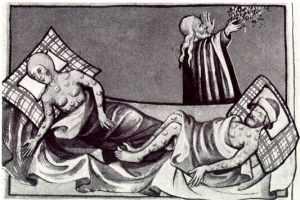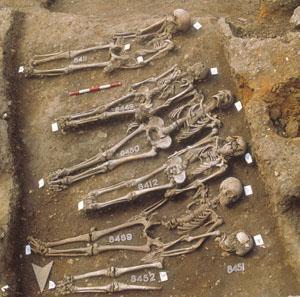Ring around the rosies,
A pocket full of posies,
Achoo! Achoo!
We all fall down.
This innocent sounding nursery rhyme dates to the Black Death and underscores the effects and forms of this disease. Bubonic Plague caused swollen and necrotic lymph nodes, called buboes, and a circular pinkish rash (the ring of the rosies). Placing flowers (posies) in your pocket was supposed to ward off the bad air, or evil spirits, or whatever your belief of choice for the cause of the disease. Of course, this didn’t work. When it progressed to Pneumonic Plague, where the victim coughed, sneezed, became short of breath, and coughed up blood, death followed very quickly (all fall down).

The Black Death was a human disaster of catastrophic proportions. Though estimates vary, when it struck Europe between 1348 and 1350, it killed 30-60% of the population and probably reduced the world population from approximately 450 million to 350 million. It disrupted travel and trade, set one village against another, and shook the foundations of medicine and religion. No one knew what caused it and prevention and treatment were mysteries. Nothing worked. No medicine or prayer or ceremony slowed its march or relieved those afflicted. If neither the medical practitioners nor the clergy of the day could help, then of what use were they?
All the populace could do was to burn or bury the dead, often in mass graves. Mourning, prayer, and fear then followed.

The cause of The Plague is the tiny bacterium we call Yersinia Pestis. That was the long held dogma anyway. More recently some have questioned this and have proposed other causes such as the Ebola virus, small pox, typhus, and several other organisms.
But recent studies seem to support dogma. Hendrik Poinar and colleagues at McMaster University in Hamilton, Ontario, recently found a very interesting way to exam the DNA from bones and teeth removed from a plague mass burial pit near London. Their “molecular probe” revealed that the causative agent was our old friend Yersinia Pestis after all.
